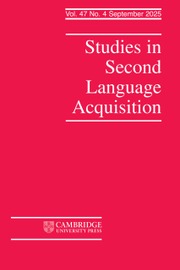Article contents
THE EFFECTS OF INPUT ENHANCEMENT ON GRAMMAR LEARNING ANDCOMPREHENSION
A Modified Replication of Lee (2007) with Eye-Movement Data
Published online by Cambridge University Press: 14 June 2013
Abstract
In his 2007 study “Effects of Textual Enhancement and TopicFamiliarity on Korean EFL Students’ Reading Comprehension andLearning of Passive Form,” Lee demonstrated that learners were betterable to correct written sentences that contained incorrect English passive formsafter exposure to texts flooded with enhanced (versus nonenhanced) passiveforms. But with enhanced forms, learners did worse on comprehension tests, whicharguably demonstrated a trade-off: More attention to forms resulted in less tomeaning. In this study, a conceptual replication of Lee’s usingeye-movement data, I assessed how English passive construction enhancementaffects English language learners’ (a) learning of the form (via pre-and posttest gains on passive construction tests) and (b) text comprehension. Incontrast to Lee’s results, I found enhancement did not significantlyincrease form correction gain scores, nor did enhancement significantly detractfrom comprehension. There was no trade-off effect. Form learning andcomprehension did not correlate. By recording learners’ eye movementswhile reading, I found enhancement significantly impacted learners’noticing of the passive forms through longer gaze durations and rereading times.Thus, enhancement in this study functioned as intuitively and originally(Sharwood Smith, 1991, 1993) proposed;it promoted noticing, but, in this case, without further explicit instruction,it appeared to have done little else.
Information
- Type
- Articles
- Information
- Studies in Second Language Acquisition , Volume 35 , Issue 2: Eye-Movement Recordings in Second Language Research , June 2013 , pp. 323 - 352
- Copyright
- Copyright © Cambridge University Press 2013
Footnotes
I presented this article at the American Association of Applied LinguisticsConference in Chicago, Illinois, in March 2011. I would like to thank GraceLee Amuzie and Sehoon Jung for their many contributions to this research. Iwould also like to recognize Aline Godfroid and two anonymousSSLA reviewers whose comments and suggestions helped megreatly in revising this article. Any mistakes, however, are my own.
References
REFERENCES
- 87
- Cited by

